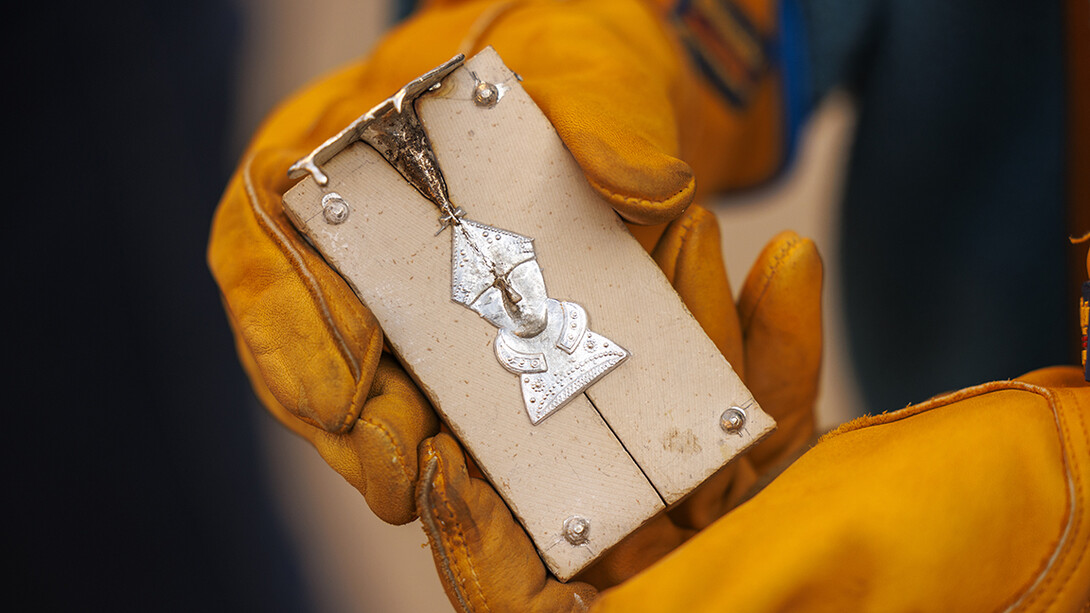
Huskers traveled to the past Nov. 2 as part of Carolyn Twomey’s History of the Middle Ages class and even walked away with a memento of the occasion.
Twomey, assistant professor of Medieval European history, in the shadow of Mueller Tower, held a practical lesson on metalcasting of pilgrim’s badges, small metal pins that people wore to commemorate their voyages to holy sites.
Through a demonstration and a souvenir of their own, Twomey hoped to connect students to the real people living in that time and show that in many ways, they thought and behaved much like we do now, like purchasing a knick knack to remember a trip taken.
“I want them to get into the shoes of someone who lived a thousand years ago,” Twomey said. “I hope they can empathize with people from the past in a little more sophisticated way by recognizing how very much like some of our modern practices this is.”
William Anderson, junior horticulture major from Gothenburg, Nebraska, said the activity brought the reading to life, and he could see the connections between the practice and some modern traditions.
“A lot of times you think of people a long time ago must have been very different, but it helps you think people are people and we’ve been that way for the longest time,” he said. “It’s cool to see people so long ago are just like me and you.”
Travelers during Medieval times would make pilgrimages to holy sites around the world, visiting a tomb or seeing sacred relics of a saint, and the badges served as souvenirs of their journey.
“On their way back, they’re going to buy the equivalent of a shot glass at the Alamo,” Twomey said.

Students poured liquid tin into stone molds to create an image of the head of Thomas Becket, also known as St. Thomas of Canterbury. Becket, the Archbishop of Canterbury, argued with King Henry II over his power over the church and was beheaded in 1170 as a result of the conflict. Faithful started visiting his tomb in Canterbury, a pilgrimage featured in “The Canterbury Tales.”
Most of these items depicted either a saint, their iconography or a symbol representing how they were martyred. There were also secular badges. Some of them represent allegiance to a group, and some satirical ones even mock the sacred ones.
Twomey said there is no textual reference to the badges from the time, making it an opportunity to learn something from material objects. She encouraged students to compare it to what people in the future might learn about the present from our coffee cups.
“No one writes down the obvious in historical sources,” Twomey said.
Anderson said the class had discussed the history of objects like these in class, but he enjoyed being able to learn more about how they were made up close.
“It really wasn’t that difficult of a process and you can really imagine this going on at different sites around Europe and the world at the time,” he said.

Twomey said people often envision the Middle Ages as a time of kings and queens and others working in the mud, and dispelling those kinds of stereotypes is one of Twomey’s goals with the class. The badges show students that even lower class people of the era were going as far as England to Spain, Jerusalem or Rome, for example, and some were creating art like the badges. Twomey said some badges were made from gold and silver, but most would have been affordable for the people making these pilgrimages.
“This is an everyday, average activity people could take on,” she said. “This is not just for the elite.”
Some pilgrims kept badges as reminders of their personal devotion. The physical travel came with spiritual transformation as well, especially those who might ask the saints for both healing for a disease or injury and forgiveness for earthly sins. Pilgrim’s badges served as a reminder of that renewal.
“In going on these journeys, you’re not only healing your body but also you’re also healing your soul,” Twomey said. “You’re doing something in the world to affect your salvation and entry into heaven.”
However, most pilgrims sacrificed for the good of their family or town. Twomey said many have been found in river crossings and molded on to church bells. People wanted to share the holy protection with others in their community and believed they could do that by infusing it into the elements.
“That act of depositing in water extends the sacred power of the object through the air molecules or through the water,” Twomey said. “We rarely find them in individual contexts.”
Paige Jennings, senior classics major from Sun Prairie, Wisconsin, said she hasn’t experienced a hands-on historical lesson like this before and she appreciated the opportunity to apply what they are learning in the classroom.
“It’s not easy to interact with objects from the past, so being able to work with replicas is really exciting, to be able to touch it with our hands and see exactly what people back then would have been working with, what it meant to them,” Jennings said.








